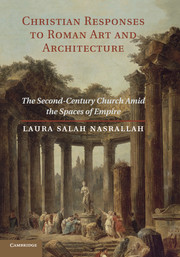 Christian Responses to Roman Art and Architecture
Christian Responses to Roman Art and Architecture Book contents
- Frontmatter
- Contents
- LIST OF FIGURES
- ACKNOWLEDGMENTS
- ABBREVIATIONS
- INTRODUCTION
- PART I FRAMING THE QUESTION, FRAMING THE WORLD
- 1 WHAT IS AN APOLOGY? CHRISTIAN APOLOGIES AND THE SO-CALLED SECOND SOPHISTIC
- 2 WHAT IS THE SPACE OF THE ROMAN EMPIRE? MAPPING, BODIES, AND KNOWLEDGE IN THE ROMAN WORLD
- PART II INTO THE CITIES
- PART III HUMAN BODIES AND THE IMAGE(S) OF GOD(S)
- EPILOGUE
- BIBLIOGRAPHY
- INDEX LOCORUM
- INDEX
- References
2 - WHAT IS THE SPACE OF THE ROMAN EMPIRE? MAPPING, BODIES, AND KNOWLEDGE IN THE ROMAN WORLD
from PART I - FRAMING THE QUESTION, FRAMING THE WORLD
- Frontmatter
- Contents
- LIST OF FIGURES
- ACKNOWLEDGMENTS
- ABBREVIATIONS
- INTRODUCTION
- PART I FRAMING THE QUESTION, FRAMING THE WORLD
- 1 WHAT IS AN APOLOGY? CHRISTIAN APOLOGIES AND THE SO-CALLED SECOND SOPHISTIC
- 2 WHAT IS THE SPACE OF THE ROMAN EMPIRE? MAPPING, BODIES, AND KNOWLEDGE IN THE ROMAN WORLD
- PART II INTO THE CITIES
- PART III HUMAN BODIES AND THE IMAGE(S) OF GOD(S)
- EPILOGUE
- BIBLIOGRAPHY
- INDEX LOCORUM
- INDEX
- References
Summary
In the late 1960s, african american children in boston were asked to draw maps of their neighborhood, near the old Mission Hill housing project. The housing project, largely white at the time, took up a large part of their hand-drawn maps, but was figured in various ways as a big blank: a no-man's land, a topography absent of marks or monuments. The streets around it, as well as schools, restaurants, and stores, were often carefully and clearly articulated, but the housing project itself was an open, unmarked rectangle. Recent critical geographers have been interested in the way “people's spatial behaviour is shaped by the hills and valleys of the invisible information and environmental stress surfaces over them.” Landscape and the built environment of the city are not neutral, but have their own rhetoric, exerting influence on the bodies of those who move through them. Moreover, humans map and interpret space, understanding the limits of their known world through the movements of their particular bodies, which are marked by gender and race.
The idea of humans rendering abstract space into concrete place is not new, nor is the concept of a city's perils or of configuring fear as a topographical blank. Subjects of the Roman Empire talked about urban decay, speculated on the limits of the oikoumenē gē, or “inhabited world,” and knew the danger of not knowing where one was.
- Type
- Chapter
- Information
- Christian Responses to Roman Art and ArchitectureThe Second-Century Church amid the Spaces of Empire, pp. 51 - 84Publisher: Cambridge University PressPrint publication year: 2010


